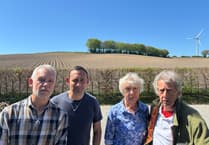One of the biggest ever patchs of a rare seaweed has been found in UK waters - the size of 900 rugby pitches, writes SWNS Reporter Tom Bevan.
Researchers discovered the vast seabed of maerl, a rare and ancient seaweed, as part of a project to look at the potential of marine habitats in tackling climate change.
Scientists discovered the living habitate carpeting the seafloor, which is part of the Fal and Helford Estuary Special Area of Conservation.
It is thought to be up to 4,000 years old and provides protection for many small marine plants and animals.
It is also extremely efficient at storing carbon at an estimated rate of 841 tonnes or CO2 annually, the equivalent to nearly 4m petrol car miles a year and five times greater than that absorbed by the combined area of seagrass, kelp and saltmarsh also in the catchment.
Cornwall Council commissioned the University of Exeter and environmental researchers Natural Capital Solutions to carry out surveys off the coast near Falmouth and Penzance to assess how effective seagrass and seaweed are at growing and storing ‘blue carbon’.
The Blue Natural Capital Project was the first time the full extent of the maerl beds and the organic matter stored in the conservation area has been measured with the discovery now marking the location as a key national site for this irreplaceable blue carbon habitat.
Dr Chris Laing, Senior Lecturer in Marine Biology at the University of Exeter and research lead on the project said: ‘‘Maerl has not been considered as a valuable carbon store to date, but our research demonstrates that as well as being a rare and valuable seabed habitat it should be a key player in coastal blue carbon assessments which is an extremely important discovery for Cornwall where the extent of the maerl beds are significant.”
The council is working with the university and other partners such as Falmouth Harbour Commissioners, Ocean Conservation Trust to protect the valuable ecosystem from threats such as anchor damage, swing moorings, nutrient discharge and sea surface temperature increases from climate change.
Cornwall’s cabinet member for environment and climate change Cllr Martyn Alvey added: "I love being on the water around the Fal and am astounded to now discover the true extent and importance of the maerl beneath the waves.
“This invaluable research has increased our knowledge of this ancient seaweed and its ability to store large quantities of carbon for centuries to millennia, highlighting its importance as a natural solution in tackling climate change.
“The project shows how these blue carbon habitats can help us in our response to both the climate and ecological emergencies if we properly protect them and allow them to fully recover.
"We are working with partners to ensure that these vital blue carbon ecosystems are protected from threats such as poor water quality, recreational boating and nutrient loading.”
Alongside maerl, other habitats including seagrass, saltmarsh and kelp are known to be valuable blue carbon stores.
The Blue Natural Capital Project, funded by Defra and the Environment Agency’s Natural Environment Investment Readiness Fund (NEIRF), has improved knowledge on blue carbon in Cornwall to provide a clearer understanding of its qualities, location and a baseline of evidence to help unlock future private funding for the natural resource.
The information found by the project will help Cornwall Council and its partners direct the next stages of blue carbon research and support the development of national blue carbon policies.
Alison Holt, founder and Director at Natural Capital Solutions, said: "Building on the blue carbon work research should focus on measuring a range of other benefits provided by maerl and other marine and coastal habitats, for example storm protection, recreation and water purification.
“Understanding how these benefits along with carbon change with habitat restoration is key to setting up blue natural capital markets in the future. In the meantime, local businesses, who have a stake in healthy marine and coastal systems may want to invest directly in habitat restoration activities.”





Comments
This article has no comments yet. Be the first to leave a comment.